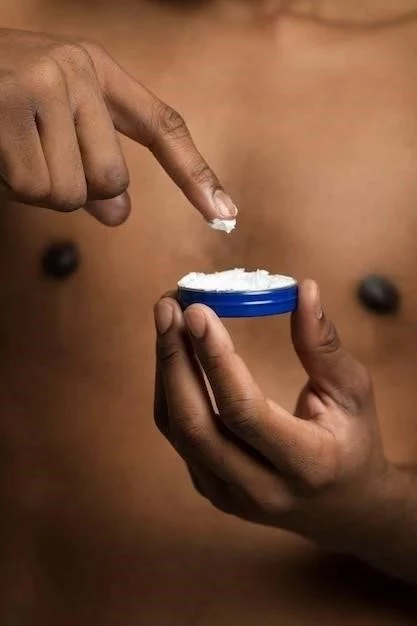

Nolvadex⁚ A Comprehensive Guide
Nolvadex, a brand name for tamoxifen citrate, is a medication primarily used in the treatment and prevention of breast cancer. It belongs to a class of drugs known as selective estrogen receptor modulators (SERMs), which means it can act as both an estrogen agonist and antagonist depending on the target tissue.
Introduction
Nolvadex, also known by its generic name tamoxifen citrate, is a medication primarily used in the treatment and prevention of breast cancer. It belongs to a class of drugs known as selective estrogen receptor modulators (SERMs), which means it can act as both an estrogen agonist and antagonist depending on the target tissue.
Nolvadex is commonly used in the treatment of hormone receptor-positive breast cancer, which means the cancer cells have receptors for the hormone estrogen. Estrogen can promote the growth of these types of breast cancer, and Nolvadex works by blocking the effects of estrogen on the cancer cells.
Nolvadex may also be used to prevent breast cancer in women who are at high risk of developing the disease. These women may have a family history of breast cancer, or they may have certain genetic mutations that increase their risk.
What is Nolvadex?
Nolvadex is a medication that is used to treat and prevent breast cancer. It is also used to treat other conditions, such as gynecomastia (enlarged breasts in men) and precocious puberty (early development of sexual characteristics in children).
Nolvadex belongs to a class of medications called selective estrogen receptor modulators (SERMs). SERMs are medications that can act as either an estrogen agonist or antagonist, depending on the target tissue. This means that Nolvadex can either mimic the effects of estrogen or block the effects of estrogen, depending on the tissue it is targeting.
In the treatment of breast cancer, Nolvadex works by blocking the effects of estrogen on breast cancer cells. Estrogen can promote the growth of breast cancer cells, so Nolvadex helps to slow the growth of these cells and prevent the cancer from spreading.
Uses of Nolvadex
Nolvadex is a medication that is used to treat and prevent breast cancer. It is also used to treat other conditions, such as gynecomastia (enlarged breasts in men) and precocious puberty (early development of sexual characteristics in children).
Nolvadex belongs to a class of medications called selective estrogen receptor modulators (SERMs). SERMs are medications that can act as either an estrogen agonist or antagonist, depending on the target tissue. This means that Nolvadex can either mimic the effects of estrogen or block the effects of estrogen, depending on the tissue it is targeting.
In the treatment of breast cancer, Nolvadex works by blocking the effects of estrogen on breast cancer cells. Estrogen can promote the growth of breast cancer cells, so Nolvadex helps to slow the growth of these cells and prevent the cancer from spreading.
3.1 Treatment of Breast Cancer
Nolvadex is a medication that is used to treat breast cancer in both men and women. It is most commonly used to treat hormone receptor-positive breast cancer, which means that the cancer cells have receptors for the hormone estrogen. Estrogen can promote the growth of breast cancer cells, so Nolvadex works by blocking the effects of estrogen on these cells.
Nolvadex can be used to treat breast cancer at different stages. It can be used to treat early-stage breast cancer, which is cancer that is confined to the breast. It can also be used to treat locally advanced breast cancer, which is cancer that has spread to nearby tissues or lymph nodes. Nolvadex can also be used to treat metastatic breast cancer, which is cancer that has spread to other parts of the body.
Nolvadex is typically taken orally once or twice a day. The dosage of Nolvadex will vary depending on the individual patient and the stage of their cancer.
3.2 Prevention of Breast Cancer
Nolvadex can also be used to prevent breast cancer in women who are at high risk of developing the disease. These women may have a family history of breast cancer, or they may have certain genetic mutations that increase their risk.
Nolvadex works to prevent breast cancer by blocking the effects of estrogen on breast cells. Estrogen can promote the growth of breast cancer cells, so Nolvadex helps to reduce the risk of breast cancer by reducing the effects of estrogen on these cells.
Nolvadex is typically taken orally once a day for 5 years. The dosage of Nolvadex will vary depending on the individual patient and their risk of developing breast cancer.
Mechanism of Action
Nolvadex belongs to a class of medications called selective estrogen receptor modulators (SERMs). SERMs are medications that can act as either an estrogen agonist or antagonist, depending on the target tissue. This means that Nolvadex can either mimic the effects of estrogen or block the effects of estrogen, depending on the tissue it is targeting.
In the treatment of breast cancer, Nolvadex works by blocking the effects of estrogen on breast cancer cells. Estrogen can promote the growth of breast cancer cells, so Nolvadex helps to slow the growth of these cells and prevent the cancer from spreading.
Nolvadex binds to the estrogen receptor in breast cancer cells and prevents estrogen from binding to the receptor. This prevents estrogen from activating the genes that promote the growth of breast cancer cells.
Dosage and Administration
Nolvadex is typically taken orally once or twice a day. The dosage of Nolvadex will vary depending on the individual patient and the stage of their cancer.
For the treatment of breast cancer, the usual dosage of Nolvadex is 20 mg once a day. However, the dosage may be increased to 40 mg once a day in some cases.
For the prevention of breast cancer, the usual dosage of Nolvadex is 20 mg once a day. However, the dosage may be reduced to 10 mg once a day in some cases.
Nolvadex should be taken with food to reduce the risk of side effects. It is important to take Nolvadex at the same time each day to maintain a consistent level of medication in the body.
Side Effects
Nolvadex can cause a variety of side effects, including⁚
- Hot flashes
- Nausea
- Vomiting
- Diarrhea
- Constipation
- Abdominal pain
- Headache
- Fatigue
- Skin rash
- Itching
- Vaginal discharge
- Menstrual irregularities
These side effects are usually mild and go away after a few weeks or months. However, some side effects can be more serious. These include⁚
- Blood clots
- Stroke
- Heart attack
- Liver damage
- Eye problems
It is important to talk to your doctor about any side effects you experience while taking Nolvadex.
6.1 Common Side Effects
The most common side effects of Nolvadex include⁚
- Hot flashes
- Nausea
- Vomiting
- Diarrhea
- Constipation
- Abdominal pain
- Headache
- Fatigue
- Skin rash
- Itching
- Vaginal discharge
- Menstrual irregularities
These side effects are usually mild and go away after a few weeks or months.
6.2 Serious Side Effects
Some side effects of Nolvadex can be serious, including⁚
- Blood clots
- Stroke
- Heart attack
- Liver damage
- Eye problems
These side effects are rare, but they can be life-threatening. It is important to talk to your doctor right away if you experience any of these side effects.
Precautions
Nolvadex should be used with caution in patients with a history of blood clots, stroke, heart attack, liver disease, or eye problems.
Nolvadex can increase the risk of blood clots, so it is important to talk to your doctor about ways to reduce your risk. These may include taking aspirin or other blood thinners, and avoiding smoking and alcohol.
Nolvadex can also increase the risk of stroke and heart attack, so it is important to talk to your doctor about ways to reduce your risk. These may include taking cholesterol-lowering medications, and eating a healthy diet and exercising regularly.
Nolvadex can also cause liver damage, so it is important to have your liver function checked regularly while taking this medication.
Contraindications
Nolvadex is contraindicated in patients with⁚
- A known allergy to Nolvadex or any of its ingredients
- A history of blood clots
- A history of stroke
- A history of heart attack
- Active liver disease
- Severe eye problems
- Pregnancy
- Breastfeeding
Nolvadex should also be used with caution in patients with a history of depression or other mental health conditions.
Interactions with Other Medications
Nolvadex can interact with a variety of other medications, including⁚
- Blood thinners, such as warfarin and heparin
- Cholesterol-lowering medications, such as statins
- Antidepressants, such as selective serotonin reuptake inhibitors (SSRIs) and serotonin-norepinephrine reuptake inhibitors (SNRIs)
- Antipsychotics, such as olanzapine and risperidone
- Anticonvulsants, such as phenytoin and carbamazepine
It is important to tell your doctor about all of the medications you are taking, including over-the-counter medications and supplements, before starting Nolvadex.
Generic Availability
Nolvadex is available as a generic medication. Generic medications are typically cheaper than brand-name medications, but they contain the same active ingredients and work in the same way.
The generic name for Nolvadex is tamoxifen citrate.
Cost and Availability
The cost of Nolvadex can vary depending on the dosage and quantity you need. However, generic Nolvadex is typically more affordable than brand-name Nolvadex.
Nolvadex is available in both tablet and liquid form; The tablet form is typically taken once or twice a day, while the liquid form is typically taken once a day.
Nolvadex is available at most pharmacies. You can also order Nolvadex online from a variety of reputable pharmacies.
How to Order Nolvadex
Nolvadex can be ordered online from a variety of reputable pharmacies. However, it is important to make sure that you are ordering from a legitimate pharmacy that sells genuine Nolvadex.
To order Nolvadex online, you will need to provide a valid prescription from your doctor. You can then choose the dosage and quantity of Nolvadex that you need.
Once you have placed your order, it will typically be shipped to you within a few days. You should store Nolvadex in a cool, dry place.
Storage and Handling
Nolvadex should be stored in a cool, dry place, away from light and moisture. The tablets should be stored in their original container. The liquid form of Nolvadex should be stored in a tightly sealed container.
Nolvadex should not be frozen.
Nolvadex should be kept out of the reach of children and pets.
Patient Information
If you are taking Nolvadex, it is important to follow your doctor’s instructions carefully. You should take Nolvadex exactly as prescribed, and you should not skip any doses.
Nolvadex can cause a variety of side effects, including hot flashes, nausea, vomiting, diarrhea, constipation, abdominal pain, headache, fatigue, skin rash, itching, vaginal discharge, and menstrual irregularities.
If you experience any side effects from Nolvadex, talk to your doctor. Your doctor may be able to lower your dose or prescribe medication to help relieve your side effects.
Nolvadex can interact with a variety of other medications, so it is important to tell your doctor about all of the medications you are taking, including over-the-counter medications and supplements.
Alternatives to Nolvadex
There are a number of alternative medications that can be used to treat breast cancer, including⁚
- Aromatase inhibitors, such as anastrozole, letrozole, and exemestane
- Fulvestrant, a selective estrogen receptor degrader (SERD)
- Palbociclib, a cyclin-dependent kinase 4/6 inhibitor
- Ribociclib, a cyclin-dependent kinase 4/6 inhibitor
- Abemaciclib, a cyclin-dependent kinase 4/6 inhibitor
Your doctor will work with you to determine the best alternative medication for you based on your individual needs and circumstances.
Clinical Trials
Nolvadex has been studied in a number of clinical trials. These trials have shown that Nolvadex is effective in treating breast cancer and preventing breast cancer in women who are at high risk of developing the disease.
One of the most well-known clinical trials of Nolvadex is the Breast Cancer Prevention Trial (BCPT). This trial involved over 13,000 women who were at high risk of developing breast cancer. The women were randomly assigned to take either Nolvadex or a placebo for five years.
The results of the BCPT showed that Nolvadex reduced the risk of developing breast cancer by 49%. The trial also showed that Nolvadex was well-tolerated, with most side effects being mild and temporary.
Recent Research and Developments

There are a number of ongoing research studies investigating the use of Nolvadex for the treatment and prevention of breast cancer. These studies are looking at the use of Nolvadex in combination with other medications, as well as the use of Nolvadex in different patient populations.
One area of active research is the use of Nolvadex in combination with other medications to treat breast cancer. For example, one study is looking at the use of Nolvadex in combination with palbociclib, a cyclin-dependent kinase 4/6 inhibitor, to treat advanced breast cancer.
Another area of active research is the use of Nolvadex to prevent breast cancer in different patient populations. For example, one study is looking at the use of Nolvadex to prevent breast cancer in women who have a BRCA1 or BRCA2 gene mutation.
Conclusion
Nolvadex is a safe and effective medication for the treatment and prevention of breast cancer. It is well-tolerated, with most side effects being mild and temporary.
Nolvadex has been shown to reduce the risk of developing breast cancer by 49% in women who are at high risk of developing the disease. It is also effective in treating breast cancer in both men and women.
Nolvadex is an important medication for the treatment and prevention of breast cancer. It is a well-tolerated and effective medication that has helped countless people fight breast cancer.

